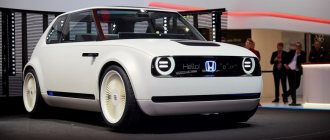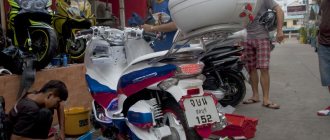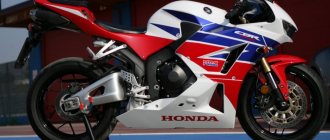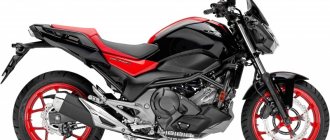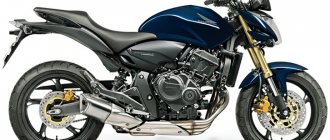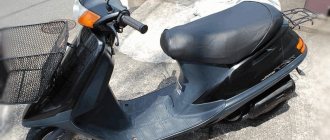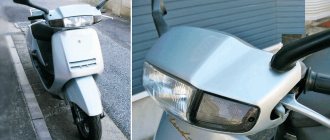| Honda CRF150R | Honda CRF150RB Expert |
Honda CRF150R cross-country motorcycle model
appeared in 2007 as a replacement for 2-stroke models, and in particular, the Honda CR85R. Having similar technical characteristics to 2-stroke 85cc models, the Honda CRF150R can only compete in the Supermini class (2T 85cc models compete in the Mini Class).
The Honda CRF 150 is based on a 1-cylinder 4-stroke liquid-cooled engine producing 23.8 hp. power and 14.1 Nm of torque. The engine is highly accelerated, with 4 valves and one camshaft (Unicam), maximum performance at 10,000-12,500 rpm.
The chassis of the Honda CRF 150 comes in the form of a steel frame, fully adjustable Showa suspension (inverted fork and rear monoshock) and disc brakes at the front and rear.
Main modifications of the Honda CRF 150:
- Honda CRF150R
is the regular version. - Honda CRF150RB (Expert)
- version for tall riders. It features 19′ and 16′ wheels (instead of 17′ and 14′), increased rear suspension travel, increased seat height, increased wheelbase (due to an extended pendulum) and a 56-teeth rear sprocket.
The Honda CRF150R model is one of the best motorcycles for learning motocross not only for children, but also for adults (RB Expert version). As a high-performance sports equipment, the Honda CRF150R requires frequent maintenance and has short engine repair service intervals.
Brief history of the model
- 2007 - start of production and sales.
Model
: Honda CRF150R;
Honda CRF150RB Expert (Europe, North America, Australia, Japan). Factory designation:
CRF150R7; CRF150RB7.
- 2008 - no significant changes.
Model
: Honda CRF150R;
Honda CRF150RB Expert (Europe, North America, Australia, Japan). Factory designation:
CRF150R8; CRF150RB8.
- 2009 - no significant changes.
Model
: Honda CRF150R;
Honda CRF150RB Expert (Europe, North America, Australia, Japan). Factory designation:
CRF150R9; CRF150RB9.
- 2010-2011 - the model is not produced.
- 2012 - the model receives a new piston and carburetor.
Model
: Honda CRF150R;
Honda CRF150RB Expert (Europe, North America, Australia, Japan). Factory designation:
CRF150RC; CRF150RBC.
- 2013 - no significant changes.
Model
: Honda CRF150R;
Honda CRF150RB Expert (Europe, North America, Australia, Japan). Factory designation:
CRF150RD; CRF150RBD.
- 2014 - no significant changes.
Model
: Honda CRF150R;
Honda CRF150RB Expert (Europe, North America, Australia, Japan). Factory designation:
CRF150RE; CRF150RBE.
- 2015 - no significant changes.
Model
: Honda CRF150R;
Honda CRF150RB Expert (Europe, North America, Australia, Japan). Factory designation:
CRF150RF; CRF150RBF.
- 2016 - no significant changes.
Model
: Honda CRF150R;
Honda CRF150RB Expert (Europe, North America, Australia, Japan). Factory designation:
CRF150RG; CRF150RBG.
- 2017 - no significant changes.
Model
: Honda CRF150R;
Honda CRF150RB Expert (Europe, North America, Australia, Japan). Factory designation:
CRF150RH; CRF150RBH.
- 2018 - no significant changes.
Model
: Honda CRF150R;
Honda CRF150RB Expert (Europe, North America, Australia, Japan). Factory designation:
CRF150RJ; CRF150RBJ.
- 2019 - no significant changes.
Model
: Honda CRF150R;
Honda CRF150RB Expert (Europe, North America, Australia, Japan). Factory designation:
CRF150RK; CRF150RBK.
- 2020 - no significant changes.
Model
: Honda CRF150R;
Honda CRF150RB Expert (Europe, North America, Australia, Japan). Factory designation:
CRF150RL; CRF150RBL.
- 2021 - no significant changes.
Model
: Honda CRF150R;
Honda CRF150RB Expert (Europe, North America, Australia, Japan). Factory designation:
CRF150RM; CRF150RBM.
- 2022 - no significant changes.
Model
: Honda CRF150R;
Honda CRF150RB Expert (Europe, North America, Australia, Japan). Factory designation:
CRF150RN; CRF150RBN.
Honest review of the new Honda CR-V (Honda SRV) R20A 2.0 VTEC 150 hp - 2021 model year
In an honest review
we will look at the new
Honda CR
-
V
(
Honda SRV
) with a
2
.
0 R20A VTEC 16v 150 l
.
with
RW
body (5th generation after restyling) on all-wheel drive
A WD
- 2021 model year and we will tell you what equipment, technical stuffing, reliability, distinctive features, fuel consumption, service life a Japanese car has, and we will also find out how much a compact one costs crossover at official dealers today.
We
recommend reading the article: “ Review of Acura RDX
(
Acura RDX
)
2021/2022 K20C 2
.
0 VTEC 16v 272 l
.
With
".
{banner_adsensetext} The Japanese company Honda,
at the end of 2021 at the Los Angeles International Auto Show, officially presented to the public an updated version of the 5th generation of the
Honda SRV
.
There were not many external changes, but the manufacturer subjected the technical part of the model to serious modernization. For reference, we note that in 2021, the Honda CR
-
V
was named the best crossover among compact
SUVs
“
C
” class.
It should be noted that the new Honda CR
-
V 5
is considered the best crossover not only in the American market, but also in the markets of European countries.
Today on the US market there is an updated
Honda CR
-
V 2
.
0 AWD
is sold at a price of $28,700 (2 million 150 thousand Russian rubles) for
the basic
LX
package ;
$31,400 (2 million 355 thousand Russian rubles) for the optimal
EX
package ;
$33,900 (2 million 540 thousand Russian rubles) for the maximum
configuration
EX
-
L
and $37,000 (2 million 755 thousand Russian rubles) for
the top-end
Touring
configuration . In turn, European dealers sell the new hybrid car with both front- and all-wheel drive at a higher price: from 33,400 to 45,000 euros (from 39,400 to $53,100 equivalent).
Russian dealers have an updated model of the urban crossover
Honda SRV 2021
, equipped with a gasoline engine
2
.
0 R 20A i
-
VTEC 150 l
.
c
is currently sold only with
AWD
paired with a continuously
variable
CVT
transmission in three fixed versions:
1
.
The basic
“
Elegance
” package will cost the buyer 2 million 350 thousand Russian rubles ($31,300 equivalent).
2
.
The optimal
“
Lifestyle
” package will cost the buyer 2 million 610 thousand Russian rubles ($34,800 equivalent).
3
.
The maximum
configuration “
Executive
” is estimated at 2 million 760 thousand Russian rubles ($36,800 equivalent).
The new Japanese crossover is endowed with a stylish and modern body appearance, emphasizing the dynamic nature of the car, capable of driving not only on city streets, but also on moderate off-road conditions. The front part of the body demonstrates a neat hood relief, narrowed headlight shades under which LED strokes of running lights and elements of head optics are visible. Above the neat false radiator grille, a curved chrome strip is visible, connecting the headlights into one composition. The high relief bumper is decorated with chrome decor and a plastic body kit. In the center of the bumper there is a wide trapezoidal mesh of the central air intake, and along the edges of the bumper, in deep niches, there are LED strips for fog lights.
The body profile is decorated with elegant ribs and stampings located on the surface of the doors. Large wheels are installed under the flared, arched arches, showcasing the striking alloy wheel pattern. The flat roof, equipped with roof rails, rests on an elegant rear pillar.
The aft part demonstrates the original design of the embossed tailgate, elegant lamp shades, demonstrating a three-dimensional pattern of LED elements. The tailgate is decorated with a chrome strip, above which there is a compact glass equipped with a windshield wiper, to the left and right of which the vertical beams of the side lamps are visible. The lower part of the stern is protected by a high bumper decorated with chrome decor, on the surface of which strips of additional LED brake lights are placed.
The car interior is decorated stylishly and modernly, using high-quality materials.
The modern equipment includes a three-spoke multifunctional steering wheel, a display for displaying a digital instrument panel, a large display of a multimedia complex, and many systems that provide comfort and safety (a set of Honda Sensing
) for people in the cabin.
In the interior of the new
Honda SRV,
the area on the central tunnel has changed (now this place has wireless charging for devices and two separate USB ports). The Japanese car is now equipped by default with an information interface with an integrated display, which is located behind the steering wheel on the dashboard in combination with analogue gauges, and an automatic dual-zone climate control is installed on the center console. In addition, the new car includes the following equipment: electronic parking brake, electric front seats (12 adjustment modes with memory function), heated all seats and steering wheel rim, as well as a modern multimedia complex, which is equipped with a 7-inch touchscreen (located on the center console ). Only high-quality soft plastic is used in the interior trim.
Thanks to a fairly large wheelbase (2660 mm), passengers in both rows have plenty of legroom, and it’s not for nothing that the new
CR
-
V
is one of the most spacious crossovers in its segment.
There is also plenty of space in the cabin in terms of width (1550 mm) and height (1185 mm). The useful volume of the luggage compartment with the rear seatbacks in the standard position is 522 liters, and if the rear seats are folded down, you get 1084 liters. In turn, unlike the basic versions, the top-end version of the Honda CR
-
V
is additionally equipped with an electric tailgate with remote opening sensors.
Honda SRV
Today, three motors are installed - two
gasoline
and one
hybrid
. The main power unit for the Russian market is still
2
.
0
—
X
liter
aspirated
(series
R20A
: 150 hp/189 Nm), which will soon be replaced by a new, more powerful one
1
.
5
liter
turbo engine
(series
L15B
: 193 hp/240 Nm) and will become the base combustion engine of the crossover under review. All new gasoline engines work in tandem only with
CVT CVT
own development. For reference, we note that the famous
2
.
4
-liter aspirated (series
K24W
: 186 hp/235 Nm) has gone into oblivion and will no longer be installed on the model
CR
—
V
from
Honda
.
Separately, I would like to note the hybrid power plant
Intelligent Multi
-
Mode Drive
, also known as
i
-
MMD
, which includes a naturally aspirated gasoline engine operating according to the
Atkinson
with a volume of
2
.
0
liters (145 hp/175 Nm) and an electric motor (184 hp/314 Nm) with a lithium-ion battery.
The hybrid device paired with a gas engine develops a maximum output of 215 horses. Moving using only electric traction, the crossover can travel no more than 2.5-3 kilometers. For reference, we note that in Hybrid Drive
, the gasoline power unit rotates the wheels of the car and plays the role of a generator, thereby providing charge to the electric motor.
In turn, Engine Drive
implies the use of only a gas engine.
On average, the fuel consumption of a crossover equipped with a hybrid unit in mixed operating mode is about 5.3 liters per 100 kilometers. e
-
CVT
variator and can be equipped with either front-wheel drive
2 WD
or all-wheel drive
AWD
, and the model will need only 9.0 seconds to accelerate from zero to hundreds (the maximum speed of the hybrid is 180 km/h).
{banner_reczagyand}
Characteristics and specifics of the power unit of the new Honda CR-V
-
2021 model year Atmospheric
4-cylinder
gasoline
engine with a
SOHC
1
installed for
16
valves): distributed fuel injection
MPI
;
motor ruler – R
–
series
;
factory series - R 20A
(
9
); cylinder capacity -
1997
cubic centimeters;
peak power - 150
horsepower at 6500 rpm;
torque - 189
Newton per meter at 4300 rpm;
gas distribution mechanism for phase regulation - i
-
VTEC
with two phase shifters (the first is at the inlet, and the second is at the outlet).
Reference information for the
R 20A 2
.
0 MPI VTEC 16v 150 l
.
With
:
— aluminum cylinder block with cast iron liners in-line format R 4
with an aluminum head for
16 V
(specifics: the valve cover is made of plastic; a wear-resistant coating is applied to the piston rings; the total weight of the unit is reduced by 5%; there are no hydraulic compensators (thermal clearances of the valves are adjusted every 45 thousand kilometers); environmental class Euro-5) ;
— power system: injector with MPI
, operating under the control of an electronic fuel supply system;
— drive mechanism: single-row timing chain
(resource - 180 thousand kilometers before updating);
— fuel consumption in the mixed cycle of use is: 7.6 liters (city – 9.8 liters/highway – 6.2 liters) of AI-92/95 gasoline per 100 kilometers;
- the volume of lubricant required for replacement is 4.3 liters (synthetics - 5 W 30
);
— approximate service life
of the internal combustion engine: 330 thousand kilometers before overhaul.
Atmospheric engine of the updated
Honda SRV 5
-
2
.
0 R 20A
, manufactured only in Japan and supplied ready-made to the assembly lines of its subsidiaries around the world.
The above-mentioned power unit works without alternative in combination with
a
continuously
variable
CVT gearbox developed by
Honda
(estimated service life - 250 thousand kilometers). A two-liter gasoline engine in tandem with a CVT accelerates the city crossover from 0 to 100 km/h in 11.9 seconds, and the model’s top speed is 188 km/h.
The new
Honda CR
-
V
, which is supplied to the domestic market, has an independent suspension (MacPherson struts in the front and a standard multi-link in the rear) and an
AWD Real Time
, which allows you to save gasoline in normal vehicle operating conditions (the mechanism is highly efficient and will always help the driver out in difficult driving situations). The crossover model under review is equipped with disc brakes (ventilated discs at the front) and electric power steering.
The updated
Honda SRV 2021
5th generation has a ground clearance (clearance) that is very decent for its segment, which is 208 millimeters.
In turn, the volume of the luggage compartment of the car is 522/1084 liters; load capacity - 553 kilograms; fuel tank volume - 57 liters; curb weight - 1577 kilograms; Dimensions of the model: wheelbase – 2660 millimeters; length – 4586 millimeters, width – 1855 millimeters and height – 1689 millimeters. The country of assembly of the version intended for Russia is Japan, the head plant of Honda Motor Company
in Ishizaki and the USA, and the subsidiary plant of
Honda Motor Inc
in Ohio.
Video
:
“A review of the new Honda CR-V
(
Honda SRV
)
5th generation in the RW body - 2021 model year “
As a result, we note that the manufacturer, the Japanese auto company Honda, announces the approximate resource of its updated model of the urban crossover Honda SRV with an R20A 2.0 gasoline engine - model year 2021, which ranges from 250-340 thousand kilometers before the possible appearance of the first significant problems, depending on the car owner’s compliance with the manufacturer’s technical regulations for the operation and maintenance of the vehicle.
THANK YOU FOR YOUR ATTENTION
.
SUBSCRIBE TO OUR NEWS
.
SHARE WITH YOUR FRIENDS
.
Specifications
Technical characteristics of Honda CRF150R and Honda CRF150RB:
| Model | Honda CRF150R/CRF150RB Expert |
| Motorcycle type | cross |
| Year of issue | 2007+ |
| Frame | steel half-duplex |
| engine's type | 1-cylinder, 4-stroke |
| Working volume | 149.7 cm³ |
| Bore/Stroke | 66.0 x 43.7 mm |
| Compression ratio | 11.7:1 |
| Cooling | liquid |
| Number of valves per cylinder | SOHC, 4 valves |
| Fuel supply system | Carburetor, 1x Keihin FCR 32mm (with throttle position sensor - TPS) |
| Ignition type | ICM |
| Maximum power | 23.8 hp (17.5 kW) at 12500 rpm |
| Maximum torque | 14.1 Nm (1.5 kg*m) at 10,000 rpm |
| Transmission | 5-speed |
| Clutch | Multi-disc in oil bath, cable drive |
| type of drive | chain |
| Front tire size | 70/100-17 40M – CRF150R 70/100-19 42M – CRF150RB |
| Rear tire size | 90/100-14 49M – CRF150R 90/100-16 52M – CRF150RB |
| Front brakes | 1 disc, 220 mm, 1-piston caliper |
| Rear brakes | 1 disc, 190 mm, 1-piston caliper |
| Front suspension | Showa 37mm inverted fork (fully adjustable), 275mm travel |
| Rear suspension | Pendulum progressive (Pro-link) with Showa monoshock (fully adjustable), travel - 272 mm - CRF150R Pendulum progressive (Pro-link) with Showa monoshock (fully adjustable), travel - 282 mm - CRF150RB |
| Motorcycle length | 1832 mm – CRF150R 1900 mm – CRF150RB |
| Motorcycle width | 770 mm |
| Motorcycle height | 1133 mm – CRF150R 1171 mm – CRF150RB |
| Wheelbase | 1260 mm – CRF150R 1285 mm – CRF150RB |
| Seat height | 832 mm – CRF150R 866 mm – CRF150RB |
| Minimum ground clearance (clearance) | 301 mm – CRF150R 336 mm – CRF150RB |
| Acceleration to 100 km/h | |
| Maximum speed | |
| Gas tank capacity | 4.3 l |
| Motorcycle weight (dry) | 75 kg – CRF150R 77 kg – CRF150RB |
Honda
CRF150R
This cheerful song of young scouts fully characterizes the youth's thirst for adventure, the desire to explore the world and experience thrills. The picture is already spinning in my head of how young extreme sports enthusiasts overcome swampy fields and dense forests, storm mountain passes and spend the night in tents on the edge of cliffs in the pouring rain, and in the morning they get up just before light and, on the still wet ground, reminiscent of mud porridge, move on. . They return from their journey dirty and exhausted, but with victory.
This cheerful song of young scouts fully characterizes the youth's thirst for adventure, the desire to explore the world and experience thrills. The picture is already spinning in my head of how young extreme sports enthusiasts overcome swampy fields and dense forests, storm mountain passes and spend the night in tents on the edge of cliffs in the pouring rain, and in the morning they get up just before light and, on the still wet ground, reminiscent of mud porridge, move on. . They return from their journey dirty and exhausted, but with victory. "From dirt to Kings!" In addition to scouts, the same proverb can describe another category of people. Those who prefer off-roading to a smooth asphalt road. Those who like to “swim” in dust and dirt. Those who are chasing the title in motocross competitions. These “dirty” competitions have always attracted a lot of attention with their exciting turns and jumps, on which riders fly several meters above the ground, as well as tracks on which an ordinary motorcycle cannot travel even a couple of meters. From year to year, motorcycle manufacturing companies work to modernize their cross-country models, looking for the ideal balance of engine characteristics and driving characteristics. Bit by bit, bikes are getting rid of extra pounds. Lighter aluminum frames are many times stronger than their steel counterparts, but two-stroke engines are slowly but surely losing ground to their four-stroke counterparts. Thus, “cross bikes” are gradually being improved, however, the appearance of completely new models on the market does not happen often.This year, Honda pleased its customers not only with a complete modernization of its line of motocross bikes, but also with the release of a completely new device, the CRF150R. It seems that Honda has decided to attack the class of cross-country motorcycles for young riders, and at the same time start a revolution - the “one hundred and fiftieth” is destined to become a four-stroke alternative to the Honda CR85R. For adult riders, the format of the bike, as well as the diameter of its wheels, will seem too small. Judge for yourself: only 14 inches in the rear and 17 in the front for the CRF150R, or 16 inches in the rear and 19 in the front for the CRF150RB-Expert. At the same time, the seat height has not changed at all compared to the CR85: 820 mm for the CRF150R and 866 mm for the Expert modification on large wheels. Given the general trend of moving from two-stroke bikes to four-stroke bikes in the senior racing classes, the introduction of a successful four-stroke model in the junior segment could be a turning point in motocross. Honda decided not to develop anything fundamentally new and on the CRF150R installed a smaller copy of the four-stroke engine of the Unicam family, previously installed on the 450 cc and 250 cc Honda CRF models. This engine has only one camshaft, which acts directly on a pair of valves, and the second pair is driven from it through rocker arms. By reducing the number of rubbing parts, it was possible to reduce mechanical losses and slightly increase power. Honda cross-country motorcycles using similar engines have already gained wild popularity all over the world, and the number of copies sold has exceeded 100,000. The engine capacity is 149 cm3. As befits racing cars, the engine is short-stroke. The 150 has a cylinder diameter of 66 mm and a piston stroke of only 43.7 mm, so the engine spins much more fun than, for example, the enduro CRF150F, where these figures are 57.3 and 57.8, respectively. mm. The compression ratio is also impressive. A two-ring piston moves inside a nickasil-lined cylinder, compressing the fuel mixture to 11.7:1. The crankshaft is made of high-strength steel with a low carbon content (to increase its reliability during constant operation at high speeds). The design of the cylinder head is the same as that of the older model, only the valve diameter is optimized for a smaller volume: for the intake valves it is 26 mm, and for the exhaust valves it is 22.5 mm. In addition, the exhaust valve rocker arms are positioned in such a way that the spark plug screws directly between them. This arrangement improves combustion of the fuel mixture and makes the overall design of the cylinder head more compact. The fuel supply system consists of one carburetor with a diffuser diameter of 32 mm. It is designed specifically for this motorcycle model and is equipped with a throttle position sensor.
All engine components are tuned for maximum performance at high speeds. Maximum power of 24.5 hp is achieved at 12,500 rpm, and the cut-off occurs at 14,300 rpm, which is 1,000 more than on the CRF250R. The torque is also quite large, equal to 14.4 Nm at 10,000 rpm. For comparison, the two-stroke CR85R has 20 hp. at 12500 rpm and 13.4 Nm at 10500 rpm. Like the larger Unicam series engines, the 150 cc unit is equipped with an automatic decompression mechanism that opens the left exhaust valve when the engine starts. This mechanism greatly simplifies starting a four-stroke. Another design refinement is the separate lubrication of the engine and gearbox. There are several advantages to this decision. Firstly, the oil supply to the crankshaft and CPG increases. Secondly, the clutch is less susceptible to heating from engine oil and its operation no longer depends on engine temperature conditions. And thirdly, you can change the oil separately, as needed. Temperature conditions, as is known, greatly affect the life of the main rubbing parts, and, as a result, reduce engine performance. Therefore, to cool it and maintain the temperature within normal limits, the motorcycle has two radiators installed. On the track, the racer is least concerned about cooling issues. Traction on the rear wheel is much more important to him. Therefore, a particularly important element of a motocross motorcycle is its gearbox, which is worth talking about in more detail. As can be seen from the technical characteristics of the engine, in order for power and torque to always be at maximum, the engine has to be “twisted” well. And so that when switching gears the speed does not drop too low, this miniature motorcycle was equipped with a five-speed gearbox with close gear ratios, which, with proper operation of the gearshift lever, allows you to always keep the engine in good shape.
When an athlete flies up about three meters on the next jump, he really doesn’t want the motorcycle’s frame or anything else to crack when landing. The life of a racer sometimes depends on the quality of its manufacture. Unlike 125 and 250 cc cars, the frame in the CRF150R is made of steel pipes. As the manufacturer explains, this decision was made based on considerations of reducing the cost of the car, which is intended for novice racers and should not be too expensive. But the pendulum was left aluminum. The design was based on the frame and suspension from the CR85R. It was slightly improved for the new engine, but all the main components remained the same. This includes a fully adjustable, cartridge-type Showa inverted fork (with a 37mm stay diameter) and a Pro-Link rear suspension with a fully adjustable Showa monoshock. True, their settings, taking into account the slightly larger (compared to the CR85R) weight of the motorcycle, have become a little tougher. The weight of the CRF150R is not so different from the CR85R, but to reduce unsprung weight, the motorcycle was equipped with a lighter and more compact brake system at both the rear and front, as well as new lightweight sports rims on both wheels. The total was 75 kg of dry weight, while the “85” had 65 kg. But this disadvantage is more than compensated by the large torque of the four-stroke engine throughout the entire rev range. The brakes, apart from lighter calipers, remain the same as on the CR85R: a 220 mm disc on the front wheel and a 190 mm disc on the rear. They are adequate to the power of the device, and the fact that in the standard version the brake hoses are not reinforced does not play a special role in this class of cars. But if you need more information from the brake system, in the list of optional spare parts you can find not only reinforced hoses, but also improved brake cylinders and calipers. The bike will definitely be a success: after all, not even a couple of months have passed since it went on sale, and you can already find a lot of tuning for it - both from the factory and from third-party manufacturers. The release of the CRF150R is sure to shake up the youth motocross market. And once again we have to acknowledge the fact that the end of two-stroke engines is inexorably approaching...
Source: https://www.motodrive.com.ua/content/Honda_CRF150R.html
Reviews
Reviews of Honda CRF150R:
Expand Collapse
The TsRF is an awesome pit bike, it goes everywhere either until it sinks up to the saddle, or until it flips over. Steers with the power of thought, up to 3rd gear - wheelies. One minus - it's too expensive.
If your budget allows you to spend ~$3300 on a purchase, then you should take a closer look at the Honda CRF 150 R - this is a 4T analogue of the 85k with the same chassis and dimensions as theirs, but a high-torque 150cc 4T engine. They say it's a very decent bike. Needless to say, with its 24 l/s in stock and a real motocross chassis, any pit bikes suck it off in unison and smacking its lips.
TEST DRIVE: Honda CRF150RB (2012) - Return
Although this model has never disappeared from the Honda lineup, the arrival of the 2012 model can be considered a Great Return to Service: with new, larger wheels and a completely rebuilt engine, the CRF150RB has become a serious fighter.
MOTOGONKI.RU, November 29, 2011 — The model appeared in the lineup in 2007, and underwent changes two years later. But now, when you buy a 2012 CRF150, you're buying a 2012 CRF150, not an "upgrade" of the 2009 model. And the “B” in the name stands for Big Wheels: 19″ in front and 16″ in the rear, which, according to Honda engineers, would make it really fast and comfortable. This was verified by CycleNews test rider Drew Petrie.
Both versions are available in the USA - R and RB. The younger brother “R” inherited from its predecessor, the CRF150R (2009), smaller diameter wheels (17 and 14 inches), which makes it look “teenage”. Related to this are the differences from the RB: for example, the former has a 26 mm shorter wheelbase and a 35 mm lower seat height and ground clearance. After installing larger wheels, the curb weight changed: the 83-kilogram “R” gained 2 kg. Otherwise the motorcycles are identical. How did this change affect the bike's performance on dirt and sand tracks?
First of all, you need to look at the changes to the engine and suspensions. Honda has completely rebuilt the 149cc powerplant, making it much smoother and more comfortable to use. To achieve this, engineers created a completely new cylinder head with modified intake ports, as well as a new combustion chamber and crankshaft shape. The design of the piston has also changed, especially its crown; they are now made from forged aluminum. The cylinder walls were “dressed” in nickasil jackets (NiCaSil) to reduce friction and increase the service life of the entire engine. Finally, the CRF150 gets a 32mm Keihin FCR carburetor with an updated fuel pump. All these changes together really gave a significant result: the motorcycle rode smoother and more confidently even at medium speeds. And the RB showed itself to be much better than its low-wheeled partner!
Due to the “large chassis”, it was possible to realize the full potential of the engine, which partially stalled on loose sandy tracks with excessive grip. To maintain good lap times, as before, you need to keep the revs high. At first, you feel some guilt towards your pony for such violence, but soon such a ride begins to bring pleasure, and the only problem is keeping the front wheel on the ground - it constantly rushes into the air.
The carburetor settings are good straight from the factory. For a mid-zone climate, the power system needs to be adjusted only when tuning the bike more deeply. The response to the throttle is smooth and adequate throughout the entire range, in no way inferior to injection models. The Japanese have clearly worked hard on the new Keihin FCR installed on the CRF150RB: there are no more delays when the handle is suddenly opened. After a full day of testing on a sandy track, Drew Petrie assured that it is unlikely that a fuel-injected version of such a motorcycle could give a better result and provide comparable performance. The torque was enough for a high-quality performance even for an adult rider, but the motorcycle is more aimed at a youth audience, the 125cc class. And, definitely, he would beat an 85 cc 2-stroke on the track. The 5-speed gearbox is smooth and soft; not once during the test did we have any problems choosing the right gear.
Chassis. There were no issues with the new Showa 37mm cartridge fork and rigid shock absorber. Even the factory settings would be suitable for a pilot weighing up to 80 kg. Usually, on dirt tracks with good grip, the weight of the motorcycle affects the handling. In the case of the CRF150R and RB, the 2 kilogram difference is not of academic interest. But in comparison with the 85cc 2-stroke, where the difference already reaches 12 kg, interest may arise... It arose before, when comparing with the 2009 model and earlier, but not with 2012: steering at speed and in slow hairpins is excellent! On the AMA Motocross track, the Honda CRF150RB performed admirably, especially in tight corners.
The only pity is that this motorcycle cannot be compared with the “85” in a real race - AMA rules do not allow entering the track with such a significant difference in volume and “due to an unfair power ratio.” In America, the price difference between the R and RB is only $100, while the difference between the RB and the average “85” is $1000. Obviously, Honda Europe has chosen to supply only the large-wheeled version to the continent. She is trustworthy!
Origin: CycleNews, Kit Palmer
